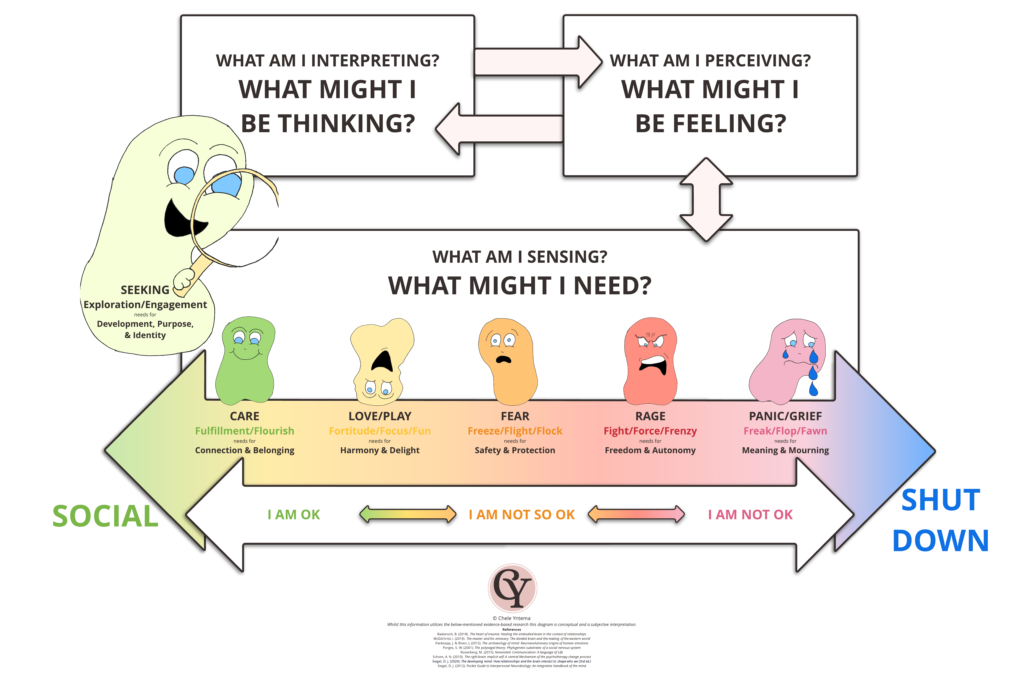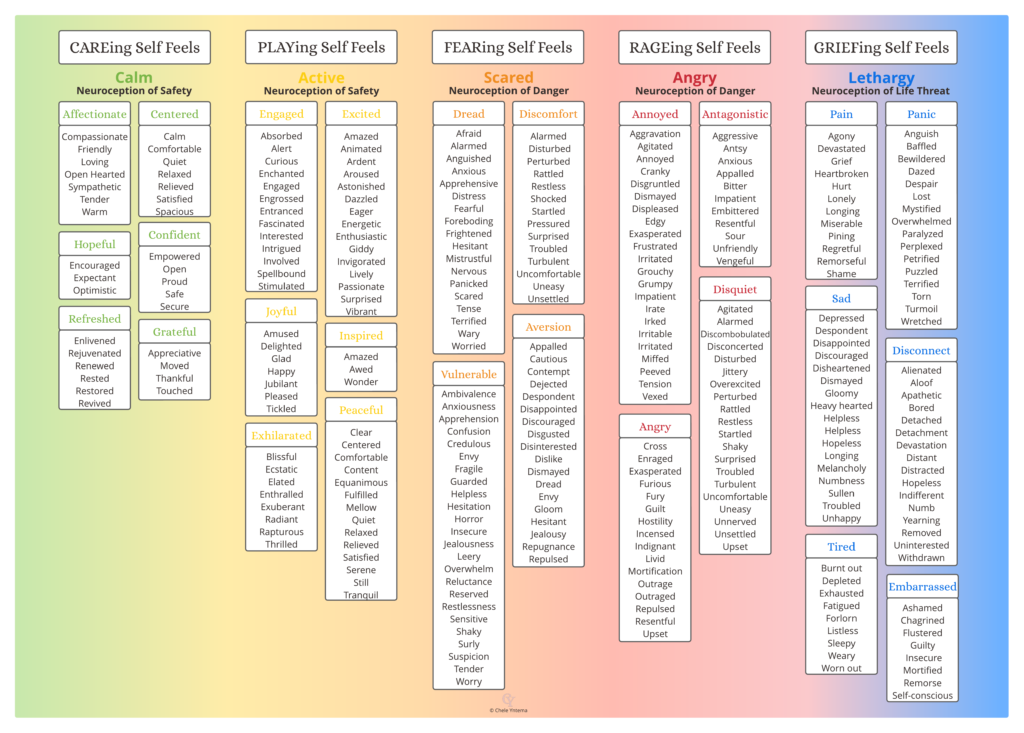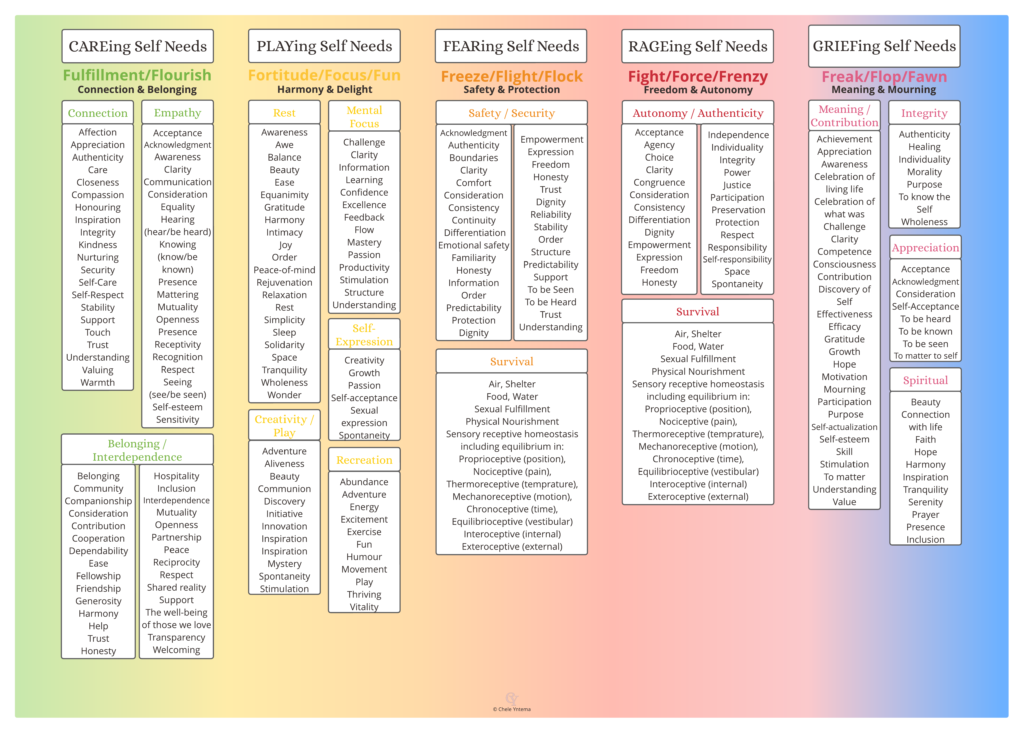Integration leads to optimal regulation… In essence, “emotional regulation” is how we use our minds, bodies, and relational processes to enhance integration.
To achieve regulation, an integrative state of coherence, in the moment and across time, the mind both monitors and modifies the flow of energy and information to differentiate and link that flow internally and interpersonally.
What this means is that processes linking differentiated elements of a system – within or between individuals – can produce the integration at the heart of regulation. In this manner we utilise both the emnodied brain and relationships to regulate the Self.
Siegel, 2020
The Value of Emotion - Part Two: Processing
What is the point of this energy we call ‘emotion’?
What is this that innately stirs from deep within, this flow of potential that arises well before the nuances within our consciousness provides us capacity to process its meaning?
I have come to appreciate that our emotions are shifts in the integrative processes of the mind; they “represent dynamic processes created within the socially influenced, value-appraising processes of the brain and the interaction of an individual with the environment” (Siegel, 2020, p.233).
Not only that, so too have I come to understand that emotion can be seen as an energy that stirs within that “evokes motion” – it is the motivational force behind why we do what we do.
And, when emotions are consciously differentiated and linked, the innate motivational mechanisms behind them become clearer; this in and of itself highlighting the value of and in emotions.
With conscious clarity of our emotions and the unique movement they stir within us, we are better able to be attuned to our Self and an Other in the co-creation of meaning and relatedness.
When we understand the nuances of emotion and how they uniquely feel within us, we are empowered to know the “flow of activation (energy) and establish the meaning of representations (information processing)” (Siegel, 2020, p.352) as it impact how we relate to our sensations, feelings, and thoughts.
Such empowerment of knowledge and impact thus allowing us to monitor and modify the initial orientation, appraisal, and arousal mechanisms within and between Self, Other, and the World. To mindfully respond, rather than react, to that which stirs from within.
So how is it then, that we might move toward this conscious clarity of that which stirs within, evoking motion? To know the flow of activation and establish the meaning of its representation from within?
One such way is through the development of compassionate communication with our Self. To connect to, and to stay present with the sensations, feelings, and thoughts through a practice of active reflection.
Active reflection can be anything that allows us to take a moment and to look back on a situation in which we felt disconnected to our authentic sense of Self and to understand more fully what was evoked.
One mode you may choose may be to write the below activity as a formal journaling process by using the diagram alongside the feelings and needs lists. Alternatively you may choose to utilise a more meditative approach by following the guided meditation offered, or you may like to read the below prompts and simply explore the ideas mindfully in your own manner.
No matter the mode of choice, empowerment though conscious awareness and attunement begins here…
Compassionate Communication with Self - RAIN
This is a four-stage process wherein I have used the acronym RAIN – adapted from Tara Brach’s amazing work – to Recognise, Acknowledge (& allow), Inquire, and Nurture.
Recognise a situation that has happened: within this journaling practice, to recognise means to observe from a place of curiosity; to consciously connect to any situation wherein challenging thoughts, feelings, or (re)actions affected you.
Acknowledge and Allow with more specificity: begin to bring into your awareness the specific swirls of perceiving and interpreting; of thinking and of feeling. Allow all that arises to come and to simply be there present with you – no need to change, fix, or judge. You might even want to differentiate these specific swirls by naming them as ‘Parts of you’. It might be helpful to use the language “there is a part of me that is telling myself….”; “there is a part of me feeling…”, “there is a part of me that senses…”
When we acknowledge these differentiated aspects with a receptive stance, these precious parts of us might open and we may responsively deepen our attention and attune to the inherent value and its hidden meaning.
Inquire with compassionate care: continuing in receptive curiosity, connect to the innate care that is within you – the desire to know your authentic Self and truth – focus on seeking to identify, name, and link the nuances of the feelings and what their hidden meanings might be. You might take a moment to connect to your body and your breath as you ask your Self: Which part most wants my attention? How am I experiencing this in my body – where do I feel it? What movement might my body want to make? Does any memory unfold? What part might I be sensing is most vulnerable here? Can I narrow it down to one most activated part? What does this part of me need, or what did it need back then? What does this part yearn for beyond everything else?
Wherever your inquiry takes you, this practice can be most transformative if you continue to come back to your body and your authentic Self. This does not have to be a complete immersion into a meditation (practice offered below); however, coming back to your body as you journal can assist you in connecting to the deeper more vulnerable part(s) of you.
Nurture with intentional Self-Compassion: once connected to the deeper more vulnerable part it is important to nurture what has arisen. Remember to just focus in on that one most vulnerable part.
For this, I shall again adapt Tara Brach’s eloquent wording:
Self-compassion begins to naturally arise in the moments that you recognize you are suffering. It comes into fullness as you intentionally nurture your inner life with self-care.
To do this, try to sense what that vulnerable, wounded, frightened or hurting part inside you most needs, and then offer some gesture of active care that might address this need. Does this part need acknowledgement, validation, understanding? Perhaps a sense of a shared reality? Is there a need for connection and belonging? Was this vulnerable part in dire need of protection and a sense of felt safety? Could it be that this part of you simply wants ease deep within?
Experiment and see which intentional gesture of kindness most helps to comfort, soften or soothe that part of you. It might be the mental whisper, I’m here with you. I’m sorry, and I love you. I love you, and I’m listening. It’s not your fault. Trust in your goodness.
In addition to a whispered message of care, many people find healing by gently placing a hand on the heart or cheek; or by envisioning being bathed in or embraced by warm, radiant light. If it feels difficult to offer yourself love, bring to mind a loving being—spiritual figure, family member, friend or pet—and imagine that being’s love and wisdom flowing into you.
After the RAIN: Remember to finish this practice with care. Come back to the present moment, slowly bringing awareness to the present moment. Attuning to a physical sense of the here-and-now. Rest in this space of awareness, going gently into the rest of your day.
A Meditation by Tara Brach
 Welcome, my name is Chele, I am a therapist primarily specialising in Trauma & Burnout. As a psychotherapist & PACFA registered Counsellor I work individually with beautiful humans such as yourself who feel alone, lost, confused, & overwhelmed; those of you who are longing for something different.
Welcome, my name is Chele, I am a therapist primarily specialising in Trauma & Burnout. As a psychotherapist & PACFA registered Counsellor I work individually with beautiful humans such as yourself who feel alone, lost, confused, & overwhelmed; those of you who are longing for something different.
As such, I offer my knowledge, skills, and inherent gifts with ears that listen to hear, and a heart open to receive who you are, no matter the suffering you bring; to support you in an exploration of how your past has impacted you and the ways that shows up presently. Together we will rediscover your hope and your sense of Self; we will reconnect you to what matters reclaiming the joy and delight in life you so deserve.
I welcome you to view my services or connect with me to explore how I can assist you in your journey.
Journaling Resources:
Mind-Body Mechanisms

Feelings & Needs Lists
A Journaling Example
Recognise a situation that has happened:
When I was at work a colleague asked to see me about an incident. She shared concerns for safety and asked if I had reported it. I knew had not officially reported the incident, however remembered documenting the incident. My colleague asked for lots of details, and I began getting confused, fretful, as well as internally defensive and upset. I had to excuse myself as I was overwhelmed. When alone I began deeply sobbing. It took more than ten minutes to compose myself. I then became angry at myself that I had to leave and could not keep myself together or assert what I knew to be true. I worried what my colleague was now thinking about me and believed that I would never be respected and that I did not belong in the team.
Interpretations & thoughts:
As I think back now, I notice within myself that as my colleague was speaking there was a part of me interpreting her questions as a sign that I had done something ‘wrong’ – this part was thinking “what did I do?” I can now recognise and name this part as the self-criticising-blaming-part.
Perceptions & feelings:
As I think back now, I notice within myself that this part of me might have been perceiving a deep sense of ‘trouble’ and was questioning the memory of what I had done, this part was scrambling to find the ‘right’ answers. I can now recognise that the self-criticising-blaming-part often remembers times when a younger part of my Self was intensely and critically questioned or blamed for things she did not do, or things that were beyond her control.
Sensations & needs:
As I think back now, I notice that at the time I was holding my breath and that my heart and mind was racing. In that moment the self-criticising-blaming-part had unknown unmet needs for felt sense of relational safety, reciprocity, clarity, and assurance of no harmful or wrongdoing.
Compassionate Connection with Self:
As I connect to my Self now, I ask: could it be that the self-criticising-blaming-part reacted with alarm in a hyper-freeze state as the questions regarding this specific incident were not anticipated? At the time was it that this self-criticising-blaming-part was deeply fearing repercussion and needed a moment to re-connect with Self for a sense of assurance, trust, and clarity of the Other’s intentions and underlying needs? Would you be willing to close your eyes and take a deep belly breath* with me and acknowledgement of just how hard confrontations like this are?
*I personally know that breath work works for me. Many Others with trauma may experience further destabilisation their system when going into their body. If this is the case for you, other options may include offering Self a butterfly hug, placing your feet on the ground and noticing how the floor feels, or perhaps even taking a moment just to notice your surroundings as they are.
Interpretations & thoughts:
As I think back now, I also notice that there was a part of me interpreting my colleagues concerns and needs for clarity as a sign she was judging my approach to safety – this part was thinking that I was not respected as equally competent. I can now recognise this part as the self-doubting-not-good-enough-part.
Perceptions & feelings:
As I think back now, I also notice that this part of me was perceiving my colleague’s expression as a loss of respect; this ignited a deep sense of insecurity and the perception of myself as an imposter or ‘less-than others’. I can now recognise that the self-doubting-not-good-enough-part often gets a flood of memories where others made assumptions and used verbal putdowns, belittlement, and character attacks against a younger part of Self when she expressed her authentic intentions, feelings, and/or thoughts behind her actions.
Sensations & needs:
As I think back now, I notice that at the time I was avoiding eye contact and shifting slowly away from my colleague. In that moment the self-doubting-not-good-enough-part had unknown unmet needs for a felt sense of understanding, confidence, and equanimity.
Compassionate Connection with Self:
As I connect to my Self now, I ask: Could it be that the self-doubting-not-good-enough-part reacted with guilt and a sense of ashamedness as she yearns to be accepted yet deeply fears being rejected? At the time was it that this self-doubting-not-good-enough-part was sensing disconnect and dissonance, perhaps this part needed a moment to re-connect with Self with an internally differentiated sense of validation, respect, confidence, and honesty? Would you be willing now to connect back to Self with a cross body butterfly hug rubbing or tapping your arms with acknowledgment that this part of us fears that she will not be valued in connection and belonging if she was to be authentically her?
Further nurturing Self and Parts in a longer moment of CARE:
Sitting with the needs for authentic Self-connection & belonging I connect to my Self with my hand on my heart, I breath and validate my parts embodied wisdom and knowledge of what was once scary and overwhelming for younger parts. I take a moment to see that the self-criticising-blaming-part was defending against potential judgement and others disappointment in her, and that the self-doubting-not-good-enough-part was protecting me from the feared repeat of relational dissonance, disconnection, and rejection.
Coming back to my Self and acknowledging the nuances within this situation and honouring the courage it took to leave, and the integrity and trust in Self that eventuated when I returned and reconnected with my colleague explaining the situation in full as I understood it. As I sit with the younger parts that were remembering times of trepidation and fear in being authentic, I allow the sadness that arises and take a moment to mourn the loss of the little one inside of me who has been hurt in the past by others “power-over” ways of being and doing. As the younger parts of me begin to feel seen, heard, understood, and with my self-criticising-blaming-part and self-doubting-not-good-enough-part relaxing in appreciation for their roles, I come back with my hand on my heart and I acknowledge for my Self and my parts, that we are valued now. With a deep breath I whisper “You are enough. You matter. You belong here.”



